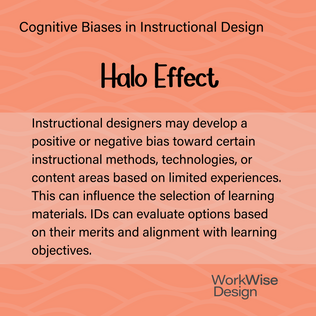top of page


3 Key Types of Assessment
There are 3 key types of learning everyone out to know: assessment for learning, assessment of learning, and assessment as learning.

Deanna Jager
1 min read


Meaningful Feedback from Assessment
Assessment is about creating meaningful feedback loops that empower employees to reach their full potential.

Deanna Jager
1 min read
The Power of Interactive Training in Corporate Learning 🚀
Interactive learning isn’t just a trend—it’s a powerful tool that transforms corporate training.

Maureen Souply
1 min read


Boosting Audience Engagement in Training Programs 📈
Engagement is the cornerstone of any successful training program. When your audience is actively involved, they retain more information

Maureen Souply
1 min read


Structuring Content in Workplace Training
Structuring Content in Workplace Training - 3 tips: define learning objectives, chunk information, use a consistent structure.

Deanna Jager
1 min read


Chunking Information in Workplace Learning
In our previous post, we talked about organizing training content. A key part of that is chunking information. Chunking is the process of...

Deanna Jager
1 min read


Tips for Organizing Training Content
Four tips for organizing training content: define learning objectives, chunk information, use a consistent structure, incorporate visuals.

Deanna Jager
1 min read
Why Employee-Centered Training Design is the Key to Engagement
Employee-centered training design shifts the focus to those who need to apply the training in their daily roles.

Maureen Souply
1 min read


Myth-Busting: One-Size-Fits-All Training
One-size-fits-all training often leads to disengagement, poor retention, and unmet learning outcomes.

Maureen Souply
1 min read


WFCP World Congress 2024
Maureen Souply presented her Competency Assessment Framework for TVET Educators at the WFCP World Congress 2024.

Maureen Souply
1 min read


Halo Effect in Learning Design - Instructional Designers
Instructional designers may develop a positive or negative bias toward certain instructional methods or technologies based on limited info.

Deanna Jager
1 min read


Anchoring Bias in Learning Design - Learners
This bias involves relying heavily on the first piece of information encountered (the "anchor") when making decisions or judgments.

Deanna Jager
1 min read


Anchoring Bias in Learning Design - Instructional Designers
Instructional designers may anchor their design decisions on initial ideas or constraints without fully exploring alternatives.

Deanna Jager
1 min read


Collaboration in Learning Design
If you manage an L&D team, you will have to work with a range of people and roles, depending on your organization. Here are some tips.

Deanna Jager
1 min read


Overconfidence Bias in Learning Design - Learners
Overconfidence Bias: Learners may overestimate their own abilities or knowledge. IDs can incorporate assessments and feedback mechanisms.

Deanna Jager
1 min read


Learning Resources for Wildfire Safety
The following resource provides a good overview of the ignition zone around your home.

Deanna Jager
1 min read


Availability Heuristic in Learning Design - Instructional Designers
Instructional designers might rely on readily available examples or solutions from their own experience or recent projects when designing.

Deanna Jager
1 min read


Using a Diverse Range of Instructional Strategies
When designing effective learning experiences, a diverse range of instructional strategies can enhance engagement and learning outcomes.

Deanna Jager
1 min read


Instructional Design Inspiration: Record Growth in Ocean Conservation
Let's celebrate and draw inspiration from Sylvia Earle's story. This reminds us that with passion and perseverance, we can make a difference

Maureen Souply
1 min read


Availability Heuristic in Learning Design - Learners
Availability Heuristic in Learners.
This bias occurs when learners make judgments based on information that is readily available to them.

Deanna Jager
1 min read
bottom of page
